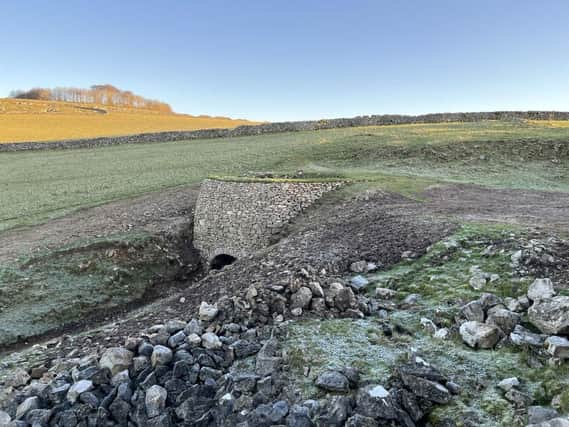Restored nineteenth century Peak District lime kiln wins top architecture award


The limestone built structure – a Grade II listed building – won the ‘Restoration of an Historic Garden or Landscape’ award for its significance in the wider landscape at Minninglow.
The award was presented by architectural historian Jeremy Musson to the landowner Mark Edge and the architect Dan Greenway of Evans Vettori, during a ceremony at Buxton Crescent’s Assembly Rooms.
Advertisement
Hide AdAdvertisement
Hide AdDerek Latham, chair of Derbyshire Historic Buildings Trust, said: “Lime kilns are a visible link in the landscape to our agricultural and industrial past.
“It is important to preserve these structures in place to reveal the stories of the landscape through time. This kiln is an important historic feature in its setting and its excellent restoration retains it for people’s enjoyment and understanding now and in the future.”
Minninglow lime kiln is of special interest because it is believed to have produced lime for the construction of the Cromford and High Peak railway and embankment, which now forms part of the High Peak Trail.
It is a large lime kiln built in limestone blocks, it stands five metres high and is set into a cutting in the hill.
Advertisement
Hide AdAdvertisement
Hide AdOnce the railway was running, lime produced by the kiln may have been transported elsewhere for use in agriculture, construction or other industries, until it eventually fell out of use.
The lime kiln collapsed during the exceptionally wet winter of 2019/2020 bringing down a large portion of the structure. Incredibly, it revealed that the last ‘charge’ of limestone was never fired and remained in the kiln. Some of the kiln walls were intact too.
Rebekah Newman, manager of Defra’s Farming in Protected Landscapes (FiPL) programme in the Peak District National Park, said: “As a significant part of the National Park’s industrial heritage and a Grade II listed building, we needed to support Minninglow Grange Farm to secure the limekiln’s future and were able to do so through FiPL.”
Through FiPL, the National Park awarded a £96,000 grant to the landowner for the restoration of the Minninglow lime kiln.
Advertisement
Hide AdAdvertisement
Hide AdWith listed building consent obtained, the restoration took place in summer 2022, carried out by Restoration Projects Ltd., and supervised by Evans Vettori Architects.
The restoration work involved replicating the limekiln’s original stone coursing – fortunately, there were photographs to refer to. Stones were specially selected and placed with weathered faces on the exterior surface. The surrounding soil was also stabilised.
Mark Edge, from Minninglow Grange Farm, said: “The lime kiln is very visible due to its size and position, it’s seen by people passing by on the trail, so when it collapsed we wanted to repair it.
“We're passionate about preserving our agricultural and industrial heritage, this lime kiln played an important part in the past. Thanks to the painstaking efforts of the stone masons and the support of the Peak District National Park Authority, we’ve been able to save this unique historic feature for people to appreciate now and in the future.”
Thanks to the Edge family, walkers are able to access the lime kiln directly from the High Peak Trail.”